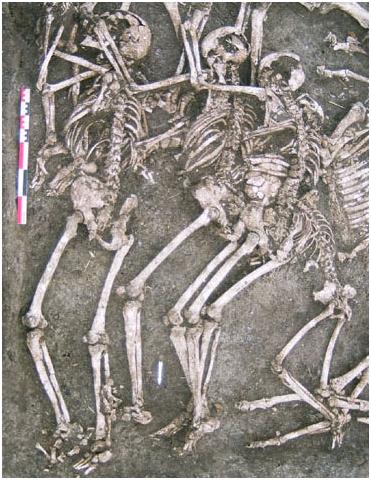UD: October 2018
“And while the attention of our men is engaged with this surrender, in another part Adcantuannus, who held the chief command, appeared with 600 devoted followers whom they call soldurii; the conditions of whose association are these, – that they enjoy all the conveniences of life with those to whose friendship they have devoted themselves: if any thing calamitous happen to them, either they endure the same destiny together with them, or commit suicide”.
(Caesar, Bellum Gallicum III:22)

The most mysterious archaeological discovery from late Iron Age Europe occurred in 2002 with the discovery of the Celtic cavalry burials in the vicinity of the oppidum of the Averni tribe at Gondole (Puy-de-Dôme), France. While the burial of Celtic warriors in the mid and late Iron Age together with their horses is unusual, this phenomenon is not unknown (isolated examples of such Celtic burials have been found as far east as Kalnovo in eastern Bulgaria). However, the Gondole burials are undoubtedly among the most bizarre in European archaeology.
The mass burial at Gondole, situated 300 meters from the rampart of the oppidum, consisted of 8 men and their horses, lined up four by four in two rows, who had been buried together in a rectangular grave. Each warrior was lying on his right side, head to the south, facing east. Seven of them were adults and the eighth an adolescent. Apart from the boy, whose hand was placed near his face, all the warriors had their left arm extended, placed on the previous skeleton.
Archaeo-zoological analysis has confirmed that the horses in the burial were Gallic horses (small horses 1.20 high)
Initial explanations of this unique archaeological phenomenon logically linked the burial to Celtic warriors killed in battle with Caesar’s forces during this turbulent period. However, the fact that no weapons, no personal belongings, no offerings, and no elements of harnessing were found with the bodies further indicated that this was no ordinary mass warrior burial. Furthermore, the theory that the men had fallen in battle with the Romans also collapsed when anthropological analysis revealed no trace of trauma on the skeletons of the warriors which would be compatible with combat, and therefore no logical scientific explanation for their deaths.
Thus, while theories abound concerning the circumstances of their deaths and the enigmatic burial rites to be observed at the site, the ‘Ghost Cavalry of Gondole’ remains one of the greatest mysteries of Celtic Europe.
.


Reblogged this on OurPantheons.
The troop of eight, one of them a youth, is seen on the Gundestrup cauldron. Was this a typical Celtic fighting unit?
It’s difficult to be sure, but it certainly suggests that it was.
more informations here (in french)
http://www.inrap.fr/la-cavalerie-gauloise-de-gondole-dans-le-puy-de-dome-244
Merci